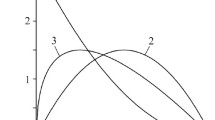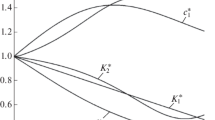Abstract
The numerical solution for the system of equations of heat friction dynamics (HFD) is obtained for the pad-disc tribosystem for use in intermittent braking mode (RST). The system of HFD equations is formulated, considering the temperature dependence of mechanical and thermal physical properties of materials, as well as the friction coefficient. The pattern of the perfect thermal contact of two sliding layers with frictional heat generation taken into account is chosen as a calculation model. The numerical analysis of the metal ceramic pad-cast iron disc friction pair is made. The RST mode consisting of three full (braking-acceleration) cycles and one incomplete (braking) cycles is studied. The change at each braking in the interconnected flashpoint, average temperature of the friction region, volumetric and maximal temperatures of the tribosystem, sliding speed, specific power, and friction coefficient is investigated.


Similar content being viewed by others
REFERENCES
Chichinadze, A.V., Raschet i issledovanie vneshnego treniya pri tormozhenii (Calculation and Study of External Friction during Braking), Moscow: Nauka, 1967.
Chichinadze, A.V., Braun, E.D., Ginzburg, A.G., and Ignat’eva, Z.V., Raschet, ispytanie i podbor friktsionnykh par (Calculation, Testing, and Choice of Friction Pairs), Moscow: Nauka, 1979.
Lee, K., Numerical Prediction of Brake Fluid Temperature Rise During Braking and Heat Soaking: SAE Technical Paper No. 1999-01-2571, Warrendale, PA: SAE Int., 1999, pp. 1–9.
Nosko, A.L. and Nosko, A.P., Cooling of braking devices of lifting-and-transport machines, Vestn. Mosk. Gos. Tekh. Univ. im. N.E. Baumana, Ser. Mashinostr., 2005, no. 5, pp. 88–99.
Hwang, P., Wu, X., and Jeon, Y., Repeated Brake Temperature Analysis of Ventilated Brake Disc on the Downhill Road: SAE Technical Paper No. 2008-01-2571, Warrendale, PA: SAE Int., 2008, pp. 1–8. https://doi.org/10.4271/2008-01-2571
Adamowicz, A. and Grzes, P., Influence of convective cooling on a disc brake temperature distribution during repetitive braking, Appl. Therm. Eng., 2011, vol. 31, nos. 14–15, pp. 2177–2185.
Kang, S.-S. and Cho, S.-K., Thermal deformation and stress analysis of disk brakes by finite element method, J. Mech. Sci. Technol., 2012, vol. 26, no. 7, pp. 2133–2137.
Manjunath, T.V. and Suresh, P.M., Structural and thermal analysis of rotor disc of disc brake, Int. J. Innovative Res. Sci., Eng. Technol., 2013, vol. 2, no. 12, pp. 7741–7749.
Adamowicz, A., Effect of convective cooling on temperature and thermal stresses in disk during repeated intermittent braking, J. Frict. Wear, 2016, vol. 37, no. 2, pp. 107–112.
Adamovich, A., Thermally stressed state of the disc during repeated braking, Fiz.-Khim. Mekh. Mater., 2016, vol. 51, no. 6, pp. 58–63.
Ginzburg, A.G., Romashko, A.M., and Titarenko, V.F., Calculation of the temperature regime of a disc rail brake, in Raschet i modelirovanie rezhima raboty tormoznykh i friktsionnykh ustroistv (Calculation and Modeling of Operation Mode of Breaking and Friction Devices), Moscow: Nauka, 1974, pp. 21–25.
Yevtushenko, A., Kuciej, M., Grzes, P., et al., Temperature in the railway disc brake at a repetitive short-term mode of braking, Int. Commun. Heat Mass Trans., 2017, vol. 84, pp. 163–173.
Slavchev, Y., Dimitrov, L., and Dimitrov, Y., Research on transient thermal process of a friction brake during repetitive cycles of operation, AIP Conf. Proc., 2017, vol. 1910, no. 1, art. ID 030003. https://doi.org/10.1063/1.5013962
Grzes, P., Maximum temperature of the disc during repeated braking applications, Adv. Mech. Eng., 2019, vol. 11, no. 3, pp. 1–13.
Yevtushenko, A. and Kuciej, M., A method to account for thermal sensitivity and friction heat resistance of materials in calculating disc brake temperature mode, J. Frict. Wear, 2020, vol. 41, no. 3, pp. 221–227.
Balakin, V. and Sergienko, V., Teplovye raschety tormozov i uzlov treniya (Thermal Calculations of Brakes and Frictional Assemblies), Gomel: Inst. Mekh. Metallopolim. Sist., Nats. Akad. Nauk Bel., 1999.
Mamkhegov, M.A., Determination of the maximum sliding contact temperature, Mashinostroenie, 1977, no. 1, pp. 107–112.
Yevtushenko, A., Kuciej, M., and Och, E., Theoretical nonlinear model of frictional heat generation in braking, Heat Trans. Res., 2019, vol. 50, no. 10, pp. 1007–1022.
Gear, C.W., Numerical Initial Value Problems in Ordinary Differential Equations, Englewood Cliffs, NJ: Prentice-Hall, 1971.
Topchevska, K., Influence of the duration of the higher contact pressure during braking on the temperature of the pad-disk tribosystem, Fiz.-Khim. Mekh. Mater., 2018, vol. 54, no. 2, pp. 107–114.
Funding
This work was financially supported by the National Science Center of Poland, project no. 2017/27/B/ST8/01249.
Author information
Authors and Affiliations
Corresponding author
Additional information
Translated by S. Kuznetsov
About this article
Cite this article
Yevtushenko, A., Kuciej, M. Calculation of Friction Characteristics of Disc Brakes Used in Repetitive Short-Term Braking Mode. J. Frict. Wear 41, 509–516 (2020). https://doi.org/10.3103/S1068366620060069
Received:
Revised:
Accepted:
Published:
Issue Date:
DOI: https://doi.org/10.3103/S1068366620060069




